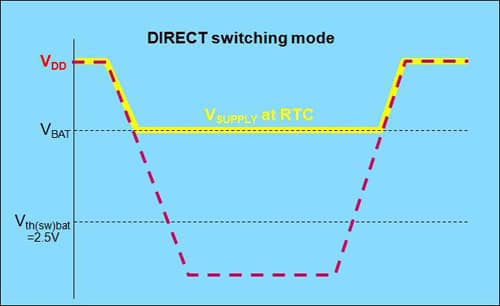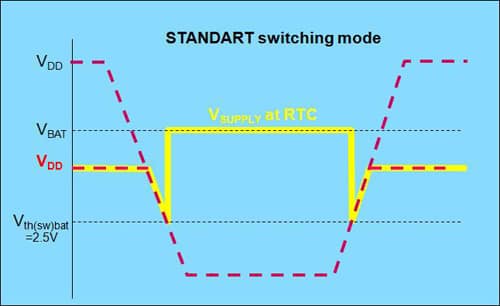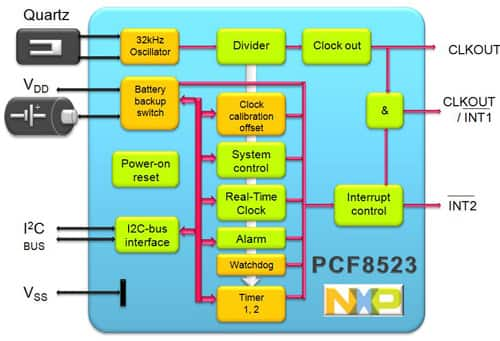Enabling Timekeeping Function and Prolonging Battery Life in Low Power Systems
投稿人:DigiKey
2011-12-14
The ability to electronically keep track of time has made it possible for electronic equipment to implement functions such as maintaining calendar time, waking up a system periodically to initiate certain actions, and time-stamping measured data. An increasing number of systems now implement time-keeping functions. These systems implement a real-time clock (RTC) function with either a standalone real-time clock device or with a processor which has an integrated real-time clock. A real-time clock (RTC) allows a system to track time and synchronize events to a time reference that is easily understood by the user.
The use of RTCs is expected in handheld, portable and battery-operated equipment, given the number of ways it enhances the final product. For example, battery operated devices are using RTCs to schedule system events and tasks, and can put the processor in deep sleep mode most of the time to significantly reduce system power consumption and prolong battery life. Further, small light-weight battery modules have wafer-size ultra-low power consuming RTCs integrated in the module and directly powered from the battery to ensure that the system timekeeping information is not lost even when the rest of the system is powered down.
Timekeeping is sometimes done using the built-in oscillator in the system microcontroller. However, in certain cases, an external standalone RTC is necessary. Using a standalone RTC has the benefits of lower power consumption, higher timekeeping accuracy, and improved reliability against system lockup.
In most systems, the on-time is magnitudes less than the off-time. Therefore, power saving during the off-time is essential. In these systems, to save power, the user will generally shut down all circuitry that is not being used. However, it is still vital that the system maintains its time-keeping function. With the use of a standalone RTC during power-down modes, the power consumption could be as low as 100 nA, compared to the current consumption of a microcontroller with integrated RTC which could be up to 2 μA to 10 μA. By transferring the timekeeping function to the ultra-low power RTC, the microcontroller can go into hibernation mode and the system would only consume 100 nA to keep the RTC running. The system wake-up procedure can be programmed optimally to suit the application.
An RTC can only be as accurate as the reference (crystal) used. A crystal's frequency characteristic depends on the shape or cut of the crystal and a manufacturer can control the crystal turnover frequency by the angle the crystal is cut. However, to manufacture crystals with different cutting angles adds complexity and cost. Possible solutions to improving timekeeping accuracy are through crystal screening, integrated crystals, keeping the crystal/RTC at a specific narrow temperature range, or using a Temperature Compensated Crystal Oscillator (TCXO). All these solutions can be achieved with the use of a standalone RTC and they are discussed in detail in NXP Semiconductor’s Application Note, Improved Timekeeping Accuracy with PCF8563 Using External Temperature Sensor (AN10652).
Lastly, a standalone RTC that is independent from the microcontroller is immune against locking up. For example, while endless program loops can lockup the microcontroller, a standalone RTC with timer, alarm or watchdog can serve as redundant backup to resetting the microcontroller and releasing it from lockup.
RTC basic operation, component selection, and features
NXP has a long tradition in offering RTCs. The key features of NXP’s RTCs are ease of interface via I²C-bus or Serial Peripheral Interface (SPI), high temperature (up to +125°C), integrated TCXO with high accuracy (±5 ppm typical) and ultra-low power consumption.
NXP’s ultra-low power RTCs, PCF2123 and PCF8523, offer a programmable alarm and timer function which give the designer the option to generate a wake-up signal on an interrupt pin. A programmable offset register also allows fine-tuning of the clock. The seconds, minutes, hours, days, weekdays, month and years registers are all coded in BCD format for easy conversion to decimal digits for printing or display a faster decimal calculation. Lowest power is achieved with a quartz crystal with capacitive loading (CL) of 7 pF. However, operation using a lower cost 12.5 pF quartz is also guaranteed. The current consumption of the device can be as low as 100 nA and may be supplied from a capacitor, supercap, coin cell battery, or harvested energy source.
Table 1 shows how long the PCF2123 and PCF8523 can run off different supply sources and compares the data with that of a microcontroller running off the same source for timekeeping function.
| Type | Capacity / Voltage | Autonomy (PCF8523, PCF2123) |
Autonomy with 3-μA Microcontroller |
| 10-μF Capacitor | 5 V → 1.5 V | 350 s to 6 min | 12 s |
| 0.1-F Capacitor | 3.3 V → 1.5 V | 500 h to 21 days | 16 h to <1 day |
| 1-F Supercap | 3.3 V → 1.5 V | 208 days to 7 month | 7 day to 1 week |
| Silver oxide V377 (watch) Ø 6 mm |
1.55 V, 27 mAh | >15 years | 1 year |
| Li-Ion CR2032 Ø20x3.2 mm |
3.6 V 40 mAh | >15 years | 1.5 years |
| AAA alkaline Ø10.5x44 mm |
1.5 V 1200 mAh | Forever | 4.5 years |
Table 1: Longevity comparison for different supply sources.
The PCF8523 has an additional battery backup circuit feature to reduce complexity in the system application. The battery backup circuitry may be configured to operate in the direct switching mode or standard switching mode. The direct switching mode (Figure 1) is suitable when the standard supply voltage is always greater than the battery backup voltage. In this mode, during power down, the RTC power source will switch from the main supply to the backup supply when the main supply voltage reaches the backup supply voltage. Likewise, during powering up of the main supply, the RTC power source will switch from the backup supply to the main supply when the main supply voltage reaches the backup supply voltage.

Figure 1: Direct switching mode.

Figure 2: Standard mode.
The standard switching mode (Figure 2) enables the RTC power to switch between the main supply and backup supply when the main supply voltage falls or rises and reaches a specific threshold voltage. This mode is suitable for systems with the main supply voltage less than or equal to the backup supply voltage. With more and more systems migrating to a 3.3 V main supply and a rising popularity of higher density lithium batteries (with typical voltage of 4 V) the standard switching mode enables switching in the battery at the lowest possible voltage to conserve much of the battery charge.
Additionally, the PCF8523 has different functional blocks whose status can be configured to generate an interrupt or to be read as a flag in the status register. These functional blocks include the timer, watchdog, alarm, and battery switchover. To be able to easily separate the interrupt of the timer, watchdog and alarm, there is an added interrupt pin in the TSSOP 14-pin version of the PCF8523.

Figure 3: Block diagram of ultra-low power RTC (PCF8523).
Product portfolio
This report focuses specifically on the PCF2123 and PCF8523 which are ultra-low power consuming RTCs. In addition, NXP offers a variety of RTCs with SPI or I²C-bus interface and the devices typically consume less than 1 μW of power. That means that all the devices can be powered by a very small battery or a small super capacitor.
For applications where very accurate time keeping is necessary, the PCF2127A and PCF2129A with integrated temperature compensated crystal oscillator (TCXO) and a 32.768 kHz quartz crystal optimized for very high accuracy and very low power consumption are recommended. The PCF2127A has 512 bytes of general purpose static RAM, a selectable SPI and I²C interface, a backup battery switch-over circuit, a programmable watchdog function, a timestamp function and many other features. The PCF2129A is similar to the PCF2127A, but with no general purpose static RAM.
The combination of an ultra-low power real-time clock, PCF2123 or PCF8523, with the microcontroller will reduce the system power consumption in the standby mode by up to a factor of 30. In most systems, since the off-time is magnitudes greater than the on-time, this will bring a significant reduction in the system power consumption and prolonged battery life.

免责声明:各个作者和/或论坛参与者在本网站发表的观点、看法和意见不代表 DigiKey 的观点、看法和意见,也不代表 DigiKey 官方政策。





